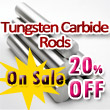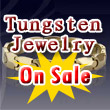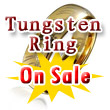Tungsten Carbide Information
Machine tools
Carbide cutting surfaces are often useful when machining through materials such as carbon steel or stainless steel, as well as in situations where other tools would wear away, such as high-quantity production runs. Sometimes, carbide will leave a better finish on the part, and allow faster machining. Carbide tools can also withstand higher temperatures than standard high speed steel tools. The material is usually tungsten-carbide cobalt, also called "cemented carbide", a metal matrix composite where tungsten carbide particles are the aggregate and metallic cobalt serves as the matrix. The process of combining tungsten carbide with cobalt is referred to as sintering or Hot Isostatic Pressing (HIP). During this process cobalt eventually will be entering the liquid stage and WC grains (>> higher melting point) remain in the solid stage. As a result of this process cobalt is embedding/cementing the WC grains and thereby creates the metal matrix composite with its distinct material properties. The naturally ductile cobalt metal serves to offset the characteristic brittle behavior of the tungsten carbide ceramic, thus raising its toughness and durability. Such parameters of tungsten carbide can be changed significantly within the carbide manufacturers sphere of influence, primarily determined by grain size, cobalt content, dotation (e.g. alloy carbides) and carbon content.
Machining with carbide can be difficult, as carbide is more brittle than other tool materials, making it susceptible to chipping and breaking. To offset this, many manufacturers sell carbide inserts and matching insert holders. With this setup, the small carbide insert is held in place by a larger tool made of a less brittle material (usually steel). This gives the benefit of using carbide without the high cost of making the entire tool out of carbide. Most modern face mills use carbide inserts, as well as some lathe tools and endmills.
To increase the life of carbide tools, they are sometimes coated. Four such coatings are TiN (titanium nitride), TiC (titanium carbide), Ti(C)N (titanium carbide-nitride), and TiAlN (Titanium Aluminum Nitride). (Newer coatings, known as DLC (Diamond Like Coating) are beginning to surface, enabling the cutting power of diamond without the unwanted chemical reaction between real diamond and iron.) Most coatings generally increase a tool's hardness and/or lubricity. A coating allows the cutting edge of a tool to cleanly pass through the material without having the material gall (stick) to it. The coating also helps to decrease the temperature associated with the cutting process and increase the life of the tool. The coating is usually deposited via thermal CVD and, for certain applications, with the mechanical PVD method. However if the deposition is performed at too high temperature, an eta phase of a Co6W6C tertiary carbide forms at the interface between the carbide and the cobalt phase, facilitating adhesion failure of the coating.
Military
Tungsten carbide is often used in armor-piercing ammunition, especially where depleted uranium is not available or not politically acceptable. The first use of W2C projectiles occurred in Luftwaffe tank-hunter squadrons, which used 37 mm autocannon equipped Ju-87G Stuka attack planes to destroy Soviet T-34 tanks in WWII. Owing to the limited German reserves of tungsten, W2C material was reserved for making machine tools and small numbers of projectiles for the most elite combat pilots, like Hans Rudel. It is an effective penetrator due to its high hardness value combined with a very high density.
Tungsten carbide ammunition can be of the sabot type (a large arrow surrounded by a discarding push cylinder) or a subcaliber ammunition, where copper or other relatively soft material is used to encase the hard penetrating core, the two parts being separated only on impact. The latter is more common in small-caliber arms, while sabots are usually reserved for artillery use.
Tungsten carbide is also an effective neutron reflector and as such was used during early investigations into nuclear chain reactions, particularly for weapons. A criticality accident occurred at Los Alamos National Laboratory on 21 August 1945 when Harry K. Daghlian, Jr. accidentally dropped a tungsten carbide brick onto a plutonium sphere causing the sub-critical mass to go critical with the reflected neutrons.
Sports
Hard carbides, especially tungsten carbide, are used by athletes, generally on poles which impact hard surfaces. Trekking poles, used by many hikers for balance and to reduce pressure on leg joints, generally use carbide tips in order to gain traction when placed on hard surfaces (like rock); such carbide tips last much longer than other types of tips.
While ski pole tips are generally not made of carbide, since they do not need to be especially hard even to break through layers of ice, rollerski tips usually are. Roller skiing emulates cross country skiing and is used by many skiers to train during warm weather months.
Sharpened carbide tipped spikes (known as studs) can be inserted into the drive tracks of snowmobiles. These studs enhance traction on icy surfaces. Longer v-shaped segments fit into grooved rods called wear rods under each snowmobile ski. The relatively sharp carbide edges enhance steering on harder icy surfaces. The carbide tips and segments reduce wear encountered when the snowmobile must cross roads and other abrasive surfaces.
Some tire manufacturers, such as Nokian and Schwalbe, offer bicycle tires with tungsten carbide studs for better traction on ice. These are generally preferred over steel studs because of their wear resistance.
Domestic
Tungsten carbide is used as the rotating ball in the tips of ballpoint pens to disperse ink during writing
Tungsten carbide can now be found in the inventory of some jewelers, most notably as the primary material in men's wedding bands. When used in this application the bands appear with a lustrous dark hue often buffed to a mirror finish. The finish is highly resistant to scratches and scuffs, holding its mirror-like shine for years.
A common misconception held concerning tungsten carbide rings is they cannot be removed in the course of emergency medical treatment, requiring the finger to be removed instead. Emergency rooms are usually equipped with jewelers' saws that can easily cut through gold and silver rings without injuring the patient when the ring cannot be slipped off easily. However, these saws are incapable of cutting through tungsten carbide. Although standard ring cutting tools cannot be used due to the hardness of this material, there are specialty cutters available that are just as effective on tungsten carbide as they are on gold and platinum. Tungsten carbide rings may be removed in an emergency situation by cracking them into pieces with standard vice grip-style locking pliers.
Many manufacturers of this emerging jewelry material state that the use of a cobalt binder may cause unwanted reactions between the cobalt and the natural oils on human skin. Skin oils cause the cobalt to leach from the material. This is said to cause possible irritation of the skin and permanent staining of the jewelry itself. Many manufacturers now advertise that their jewelry is "cobalt free". This is achieved by replacing the cobalt with nickel as a binder.
Go to <<Prior Page






 sales@chinatungsten.com
sales@chinatungsten.com